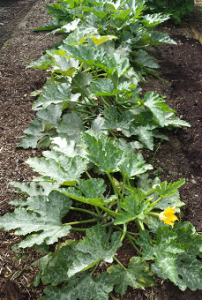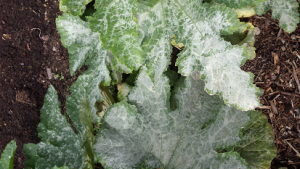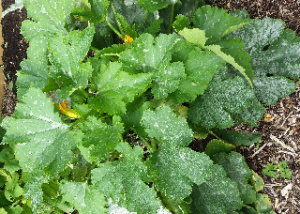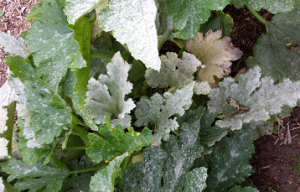
Beware of Fungi
At the beginning of July I wrote about my concerns with several days of very mild and damp weather that favours the growth of fungi. My main worry was rust fungus on our garlic, onions and leeks. Did this mean we should expect a bad season for the fungus powdery mildew on our newly planted courgette plants? Powdery mildew on the leaves of courgettes is a perennial problem and I have not yet managed to tie down the years when it’s likely to be worse, or find a prevention. As fungi like damp conditions, then I think with the mild weather we are having, a warning sign should be put up “Beware of Fungi”. Anyway this year I set up an experiment to see if powdery mildew could be controlled and I’m reporting what happened in this blog post.
A quick summary
To quickly summarise the experiment: I planted six courgette plants and sprayed them with either copper sulphate solution or milk solution every two weeks. I sprayed with the two different solutions, alternating the plants in the row. Plants 1, 3 and 5 got copper solution and plants 2, 4 and 6 were treated with milk solution. You can read my original post on setting up the experiment here.
Result of my experiment

Courgette plants grown, but all have powdery mildew
It is often difficult to get clear cut results in an experiment, especially when trying one for the first time. Most of the time, you hope to at least learn something to help you in setting up the next experiment. Several modifications later you might be able to run the “definitive” experiment. Then repeat it, so you can say with a level confidence that the outcome you get is mostly likely what’s going on. So let’s look at what happened in my first experiment with the two different solutions.

Powdery mildew on the leaves of two adjacent plants. Milk solution treated at the top of the picture and copper solution treated at the bottom

One of the milk solution treated plants with some powdery mildew but still growing and producing courgettes
There was a difference between the copper sprayed and the milk sprayed plants. Unfortunately it was not the difference I was hoping for! All the plants still got a dose of mildew. Were any of the sets of plants: 1, 3 & 5 versus 2, 4 & 6, showing any less mildew? No. But the set 2, 4 & 6 did look much healthier. This set was the milk solution treated plants.
Set 1, 3 & 5 treated with copper solution seem to have restricted growth. Plant No. 5 is now in a poor state and has stopped producing courgettes.

Plant No.5 with a lot of small leaves with powdery mildew, and some dying
No control
Anybody trained in scientific methodology would immediately spot that I did not include any “no treatment” control plants. These control plants sprayed with just water may have told us what would have happened this year if we had done nothing to prevent mildew. I hold my hands up to this omission, but it was deliberate. Given the warm damp conditions, I felt I had to treat all the plants in one way or another, to have the best chance of avoiding any of them succumbing early to mildew infection. Ironically, as with plant No. 5 especially, and the other plants in the copper solution set, these seem to have been adversely affected by copper sulphate itself.
What I learned
As I say, you hope to learn something with each experiment. Was spraying every two weeks too much copper sulphate? Maybe it was too much and inhibited plant growth, but, it did not stop the mildew. If very little mildew had appeared on the copper solution set, indicating that it had been effective in mildew control, then next year I would have tried less frequent spraying or a more dilute solution very two weeks. Ruling out copper solution then I think we must still give milk solution another go. Unless something else comes to mind, my design for next year’s experiment with milk solution will include “no treatment” controls.
Next year
Perhaps by the end of next year’s growing season I’ll have an answer on the effectiveness of milk solution as a fungicide. A positive result would be great for many reasons and would be a fantastic piece for updating the relevant chapter in my eBook A Wet Look At Climate Change.
If you would like to hear more about fungi and the impact of moisture due to seasonal variation, please sign up for email alerts of my blogs.
Useful background and various topics on moisture and humidity are discussed in my eBook “A Wet Look At Climate Change”.
Welcome to my world of moisture

Leave a Reply